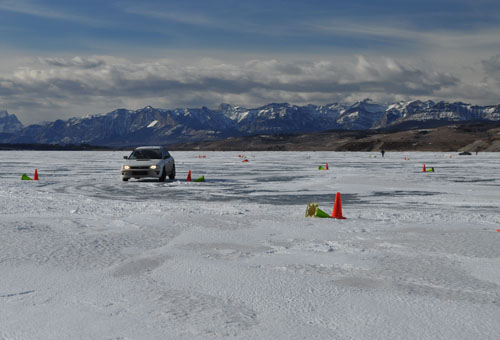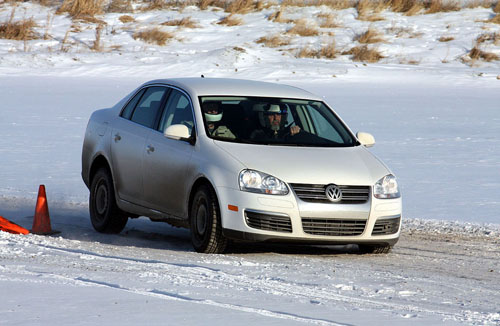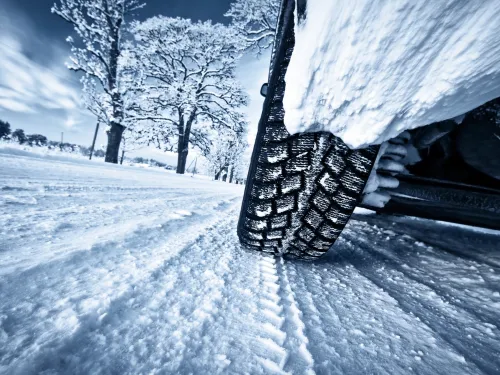8 tips for getting a grip on winter driving
SNOWSEEKERS
You're Canadian. You have rear-wheel drive or all-season tires and you know how to handle a vehicle on snow and ice, thank you very much.
Winter is here and it's time for good winter tires and a little brush-up on how to drive safely in the snow.
All photos by Jorge Dascollas
These are just some of the common reasons drivers don't put winter tires on their vehicles.
Jorge Dascollas is a veteran driver on all kinds of terrain, from racetracks to icy obstacle courses. He's been rally racing since the mid-'80s and is the technical judge on the reality TV show, Ice Road Showdown on CMT. He's heard all the excuses for not getting winter tires.
Watch this video of a pro behind the wheel on ice and snow.
Typically, he says people think all-seasons are good enough. “They are not up to the job.” He explains that the rubber compounds isn’t as good as a winter tire, which stays flexible at low temperatures.
In fact, studies have proven that. The Traffic Injury Research Foundation report found that stopping distances for vehicles with all-seasons can be 30% longer than for vehicles with winter tires.
“Reduced stopping distance in unexpected situations is perhaps the best reason to choose winters tires." said James Bliss, Fountain Tire’s spokesman. "The ability to stop quickly in a blizzard or on snow or ice covered roads can spell the difference between an anxious moment and a costly collision.”
The TIRF study also reported that tests showed winter tires have better traction at -40°C than all-season tires at 4°C. Winter tires grip harder, offering better traction and outperforming all tires at or below 7°C, whether the road is snow covered, wet, icy or dry.
- Hit the road with SnowSeekers: One man's quest to ski all 78 resorts in Alberta and B.C.
- Cranbrook is your Powder Highway base camp.
“I’ve been telling friends for years to get winter tires, but they wouldn’t listen. Finally, some of them did and they, ‘Wow, I can’t believe the difference,’” Dascollas said.
Dascollas’ top tips for winter driving.
1. Please get winter tires. "All seasons" are OK if you live in L.A, Houston or Phoenix, but aren't up to the task for winter cities like Calgary. All-weather tires are much better than all seasons but not as good as winter tires.
 Don't attempt these moves unless you're a pro like Dascollas, a longtime rally driver.
Don't attempt these moves unless you're a pro like Dascollas, a longtime rally driver.
2. Look far ahead. Too many people drive with their eyes fixated at the rear bumper of the car in front of them. The smart thing to do is keep your eyes on what is happening several cars ahead of the one in front of you. If you can see a vehicle four cars ahead of yours slamming on the brakes, you will have the advantage of being able to slow down before the driver in front of you even touches his brakes. Looking ahead is a great habit everyone should develop for year-round driving.
Winter tires are much more flexible for snow-covered roads.
3. Snow grips better than ice. If you're driving on a major road after several days of -10 C or less temperatures, and you see two dark "apparently" clear tracks on your lane with the white stuff on both sides and in the centre, try riding the snow when you have to brake. Snow has more grip than ice, and it’s here the gravel gives it additional grip. Also, be aware that more often than not, what you see as dark pavement could actually be black ice.
4. Lane changing. When changing lanes watch out for accumulated snow or slush in between the lanes. It’s common to see drivers on fast-moving roads, changing lanes over icy conditions where there is a few inches of snow or slush accumulated between lanes. When the front tire hits that stuff, it’s like pressing the brake on that tire alone. This often creates an effect where the front end gets yanked to one side, making the rear of the car sway around. This could result in spinning out in the middle of traffic - or even worse - a highway.
5. Keep your distance. Our brains get programmed with a certain “safe” distance during those full-grip months of spring summer and fall. That’s why we always hear the old joke that people forget how to drive during the first snow storm. What’s really happening is that the brain has forgotten to readjust the distance for the conditions.

Always keep your distance from the cars ahead of you when driving in winter conditions.
6. Smooth = Fast and Safe. People must drive smoothly during slippery conditions, which means no sudden manoeuvres, no hard braking or accelerating from the start or from any speed. Hard or sharp movements is what often makes a car lose its grip on the road. It is the one thing many drivers don't pay attention to, including those who contested in the Ice Racer Showdown. "As a judge I often gave them this advice: Smooth = Fast and Safe."
7. Slow down! Unless you're an experienced rally driver, you will not be able to handle your car like you do in normal conditions. Your driving style needs to be changed for ice and snow. Rally drivers are experienced and reading and feeling road conditions, and then adjust their driving accordingly. You must learn to do the same.
8. Take a lesson. Enrol in a winter ice-driving training course. For example, the Southern Alberta Solosport Club, a non- profit organization for sports car enthusiasts offers courses as a public service from January to March. For more information, contact S.A.S.C. at: @email.

Taking a refresher lesson is smart for learning some tips on how to keep your cool when driving in harsh weather.
“Every winter when I go out and drive I see all of these errors daily. It would be nice to see more people take those lessons," says Dascollas.
Are you ready for winter driving? Share this story with your friends who may need some tips too.
Like Our Facebook Page
